When disaster strikes, you may only have minutes, even seconds get the heck outta there. A good preparedness kit is essential for a quick evacuation and can mean the difference between life and death. Your bug out bag backpack should contain enough supplies to get you through 72 hours, or until help arrives.
When you retreat to your bug-out location, your kit will ensure that you are self-sufficient and protected for the time being. But what if you do it by car? Wouldn’t it be nice to have a few extra supplies in your car as well?
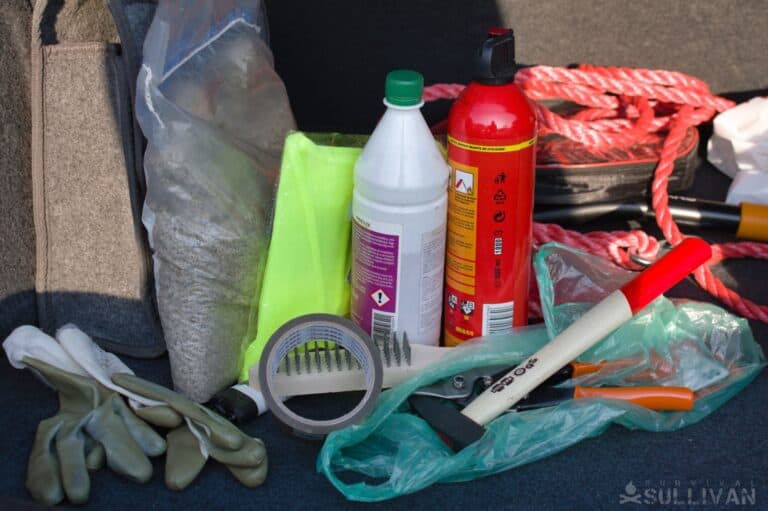
Keeping in mind that a car allows you to have a bigger BOB because it has the room and you don’t have to carry it (unless you need to abandon your vehicle), let’s see what you should add to your car’s bug out bag.
If you’re looking for a checklist of all of these items to print and check off as you get them, you can get it here.
Table of Contents
Know Your Needs
While you’ll have to be selective about what you pack in your BOB, there’s an array of optional extras that you might want to include, depending on your climate, terrain and needs. If you have pets, elderly people or children in your care, you’ll need to adjust your BOB accordingly.
It’s easy to overstock, giving in to the mentality that you might just need everything you’ve packed. Don’t hesitate to cut back. In an emergency, you’ll be thankful that you lightened your load, as you’ll likely have to move quicker and save fuel.
Also keep in mind that if your car is burglarized, everything in it including your guns might disappear. You definitely don’t want to invest all your survival money into tools and gear for your car, even if bugging out is your plan A.
Water
In any emergency situation, water is an essential need and can quickly become a scarce commodity. On average, humans can go only three without water before they perish from dehydration.
For survival, each person will need a minimum of 1 gallon of drinking water per day, so make sure than several gallons of bottled water inside the trunk.
Put some of it in a thermos if you can to protect from heat and temperature variations, but don’t shy away from keeping water in plastic bottles. You probably don’t want to have too many thermoses in your car.
Disclosure: This post has links to 3rd party websites, so I may get a commission if you buy through those links. Survival Sullivan is a participant in the Amazon Services LLC Associates Program. As an Amazon Associate, I earn from qualifying purchases. See my full disclosure for more.
If you’re sourcing water from nature, keep a purification system on hand. A lifestraw or a sawyer mini will be more than enough. You might want to include a stainless steel cup, so you can make coffee or tea.
Now, in a survival situation, you’ll need to keep your energy levels up. An energy drink can be stored in a car cooler, but keep in mind the expiration/best by date.
Food
If you can get away with water being kept in a hot trunk, food is another story. You cannot store most foods for too long, but what you can do is get an (electric) car cooler, that should keep things cool for days on end.
Even so, you’ll want to stick to foods that won’t be affected by extreme temperatures.
The list of the best emergency foods to store in your car:
- Granola and energy bars are light and nutritious and will sustain you for the short term.
- Freeze-dried meals such as those made by Mountain House have a long shelf-life and need only boiling water.
- Peanuts and raisins are a trusty BOB essential for their high calorie content and minimal weight.
- A small packet of sugar to add to tea or coffee is a mood booster and a source of instant energy.
- Instant mashed potatoes are compact, light and easy to prepare. They’re suitable for young children, too, and provide a nutritious meal when food is scarce.
Of course, when you’re ready to evacuate, you should definitely be adding as much extra food as you can, including canned goodies (that are typically best kept at temps between 50 F and 70 F – 20 C to 21 C).
The nice thing about cans is that they can be scattered through the many small places inside your car, leaving the enough room for the rest of your supplies. Water bottles can fit too:
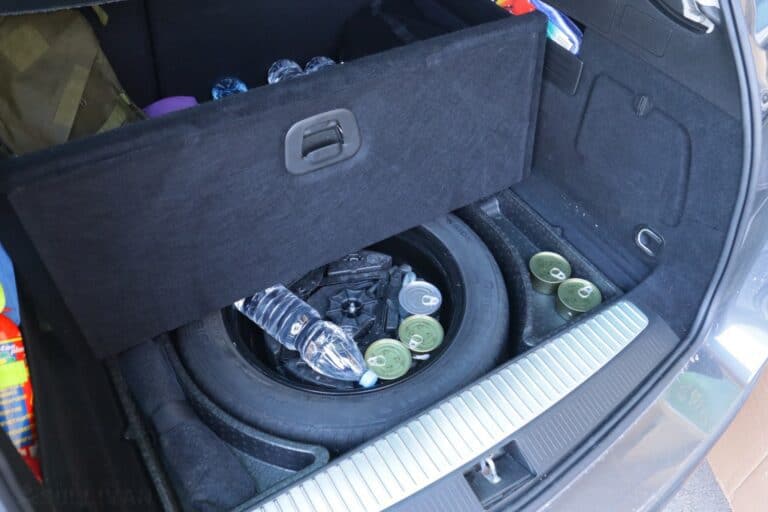
First Aid
For us preppers, the standard first aid kit that comes with our car isn’t enough. It’s a good start, but even better, let’s pretend we don’t have it, so we can build our own from scratch.
- Be sure to include hand sanitizers and wet wipes to keep your hands germ-free. Falling ill during a crisis can undo all you hard work in an instant, especially if there is no medical assistance for hundreds of miles.
- You may need to spend several days in the wilderness to find shelter, so remember to pack foot care products, insect repellent and a snake bite kit. Gold Bond foot powder soothes chafed and irritated skin and kills pesky bacteria.
- Plasters and antibiotic ointment are obvious choices for treating small cuts, but consider including tampons or maxi pads, which can absorb blood from deeper wounds.
- If you live in a hot climate, sunscreen and a brimmed hat are essential.
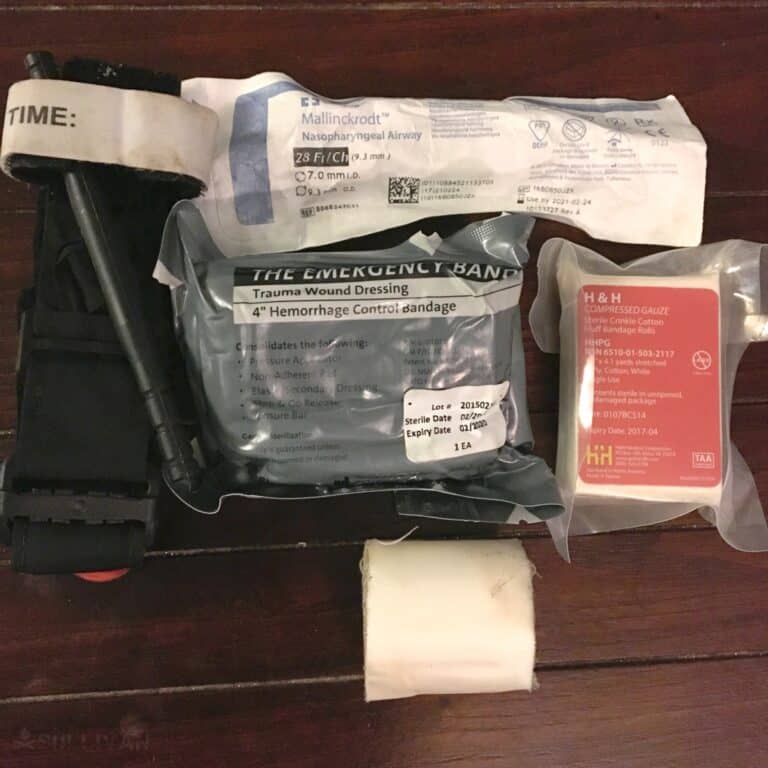
You can go ahead and put your meds inside a wide-mouth thermos, or inside that electric car cooler if you have the space. This will ensure they stay at a slightly lower temperature on hot, summer days. It also protects against temperature variations which are also known to decrease shelf life.
Fire and Lighting
- A good supply of disposable lighters and waterproof matches will keep the fire going.
- A headlamp will provide light while keeping your hands free to forage and explore.
- You can get creative with tinder, opting for Vaseline-covered cotton balls, wooden coffee stirrers, bark shavings or dryer lint to feed the flames. Military heat tabs are an optimal extra and will keep the fire burning even with wet wood.
- Invest in a quality flashlight, and keep it inside ziploc bags, remove the batteries and put them in separate bags. Remember to conserve battery power whenever possible, in case you need to signal someone to come for your rescue. Better yet, get a hand-crank flashlight.
- Chem lights can be clipped to your clothing, making you visible from a distance. Tie them to a piece of cord and swing them in a circular motion for an effective signaling device.
- A road flare or two are also a good idea if you want people to notice you so they can come to your rescue.
Shelter and Warmth
Keeping warm is a priority when in survival mode. Aside from sleeping bags and blankets, your clothing should be season-appropriate and protective.
- Long pants (preferably cargo pants because they have more pockets)
- a waterproof jacket lined with fleece to protect from harsh weather
- a hat
- UVA and UVB sunglasses
- thermal underwear
- extra pair of socks and underwear (two of each)
- hiking boots
- Convertible (zip-off) pants are a favorite among preppers for their adaptability.
- While a tent is a nice-to-have, it may not be practical for your trunk’s size constraints, and may take too long to erect. Consider a lighweight poncho or camouflage tarp shelter which requires only a few 3-foot sticks and some parachute cord to set up. A car’s trunk typically has more space than a backpack, not to mention you don’t have to carry the items on your back – so go ahead and add more items than you need.
- Consider a few space blankets just in case. Aluminum foil also has plenty of alternative uses, anyway. You can put it on your windshield, for example, to keep the sun’s rays away.
Tools and Gear
There are various common household items that can prove to be lifesavers in a disaster situation.
- Duct tape is very versatile and can be used to create a splint for injured limbs, repair a tent, fashion a piece of rope or create a sharp weapon, among numerous other uses.
- Invest in a quality multi-tool, such as a Leatherman, with needle-nose pliers for cutting. A back-up Swiss Army knife is also a good idea if you can get a good one cheaply.
- Superglue is handy for repairing broken equipment and is even known to seal a small cut. Like duct tape, this power adhesive is great for creating makeshift weapons like arrows or spears.
- Aluminum foil is a survival staple with a myriad of uses, including food preservation, mirror signaling and water containment.
- Trash bags are worthwhile BOB staples, not only as containers for your preps, but also as improvised raingear when you need extra protection from extreme weather or flash flooding. You can also fill them with dry leaves or newspaper, and you have a homemade insulation blanket.
- Work Gloves. You never know when you might need to move heavy objects, such as downed tree branches.
- Seat-belt cutter / window breaker. You’ll need one of these to evacuate the car if you get trapped inside for whatever reason (car crash, sinking car etc.)
- Mini binoculars are great scouting tools for monitoring your perimeter for friends or foes.
- Bandanas aren’t just fashion items. In the wild, the bandana rivals the usefulness of duct tape. It can be converted into a sling (both the weapon and the first aid variety), used as an eye patch, dust mask or set of ear muffs or fashioned into a tourniquet. They’re light, cheap and flat, so be sure to pack a bunch!
- Consider a mini fishing kit, complete with at least 100 feet of fishing line, sinkers and small hooks. Small insects or worms can be used as bait.
Navigation
You’ll need to explore your surroundings in search of food, water and possible rescue.
- A GPS device, such as a Garmin, with a sustainable power source is a plus. Otherwise, you can settle for a simple compass.
- Printed and laminated topographic maps of your city or town, and of your region. Ideally, you should be able to navigate using these maps all the way to your bug out location.
- While scouting, use red spray paint or colored duct tape to mark your path in unfamiliar territory to avoid getting hopelessly lost.
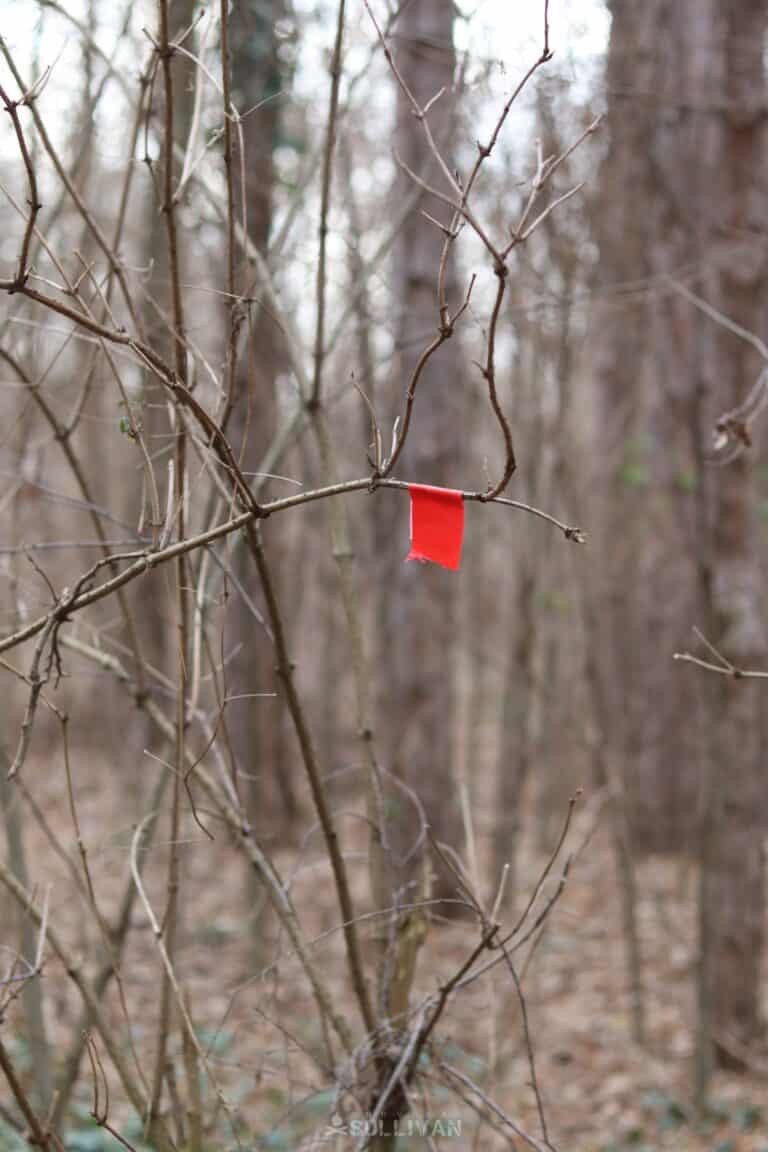
Self-Defense
You may well be facing a WROL situation, and this means that you need to be prepared to defend yourself or your family.
- The number one option is a firearm. A handgun can be kept near the driver’s seat, and/or you can opt for a long gun kept in the trunk.
- A good fixed blade survival knife or machete is a noble back-up. In fact, you should have one (again if the law allows it), anyway.
- Other non-lethal weapons may include clubs, and if need be, you may use your car’s snow shovel to defend yourself.
- A dash cam is cheap could be a lifesaver should you be in a car crash, or if someone attacks you.
Communications
Apart from flares, there are more discreet ways of communicating with other survivors who may be close by.
- Disposable cell phones and satellite phones are great ways of making contact with the outside world when SHTF.
- If network coverage in your area is disrupted, a solar powered emergency radio will keep you up-to-date with the latest developments.
- For short-distance communications, CB radios may prove useful for locating other survivors within 10 miles.
- If you wish to attract attention, equip yourself with a whistle to alert your own party, or others, of your presence.
- Have at least a couple of ways to charge your cell-phone (car charger, solar panel, power bank).
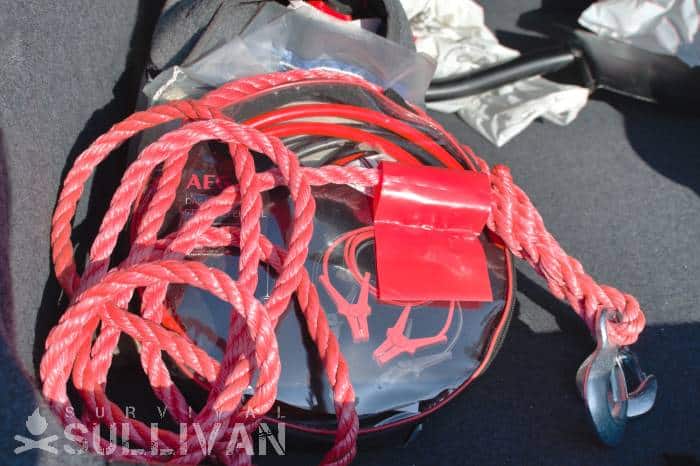
Other Survival Items
In addition to your car’s bug out bag, you should have a roadside emergency kit with the items necessary to get your car going again should something happen. Things like:
- a good shovel (avoid the collapsible kind as there’s an increased risk that it will break)
- an axe
- toilet paper
- paper towels
- rags
- ice scraper
- a chainsaw
- engine oil
- signaling mirror
- jumper cables
- coolant
- extra fuel in a Jerry can (read up on how to safely store it)
- 550 Paracord
- transmission fluid
- towing cable or rope
- a rooftop carrier (for even more stuff to carry with you when you evacuate)
- coffee filters (lots of survival uses, the one that comes to mind is the ability to prefilter water from debris)
- fire extinguisher
- and even a separate box with spare parts such as spark plugs
- cash (small bills, coins too for vending machines – could be critical right after SHTF)
- and more.
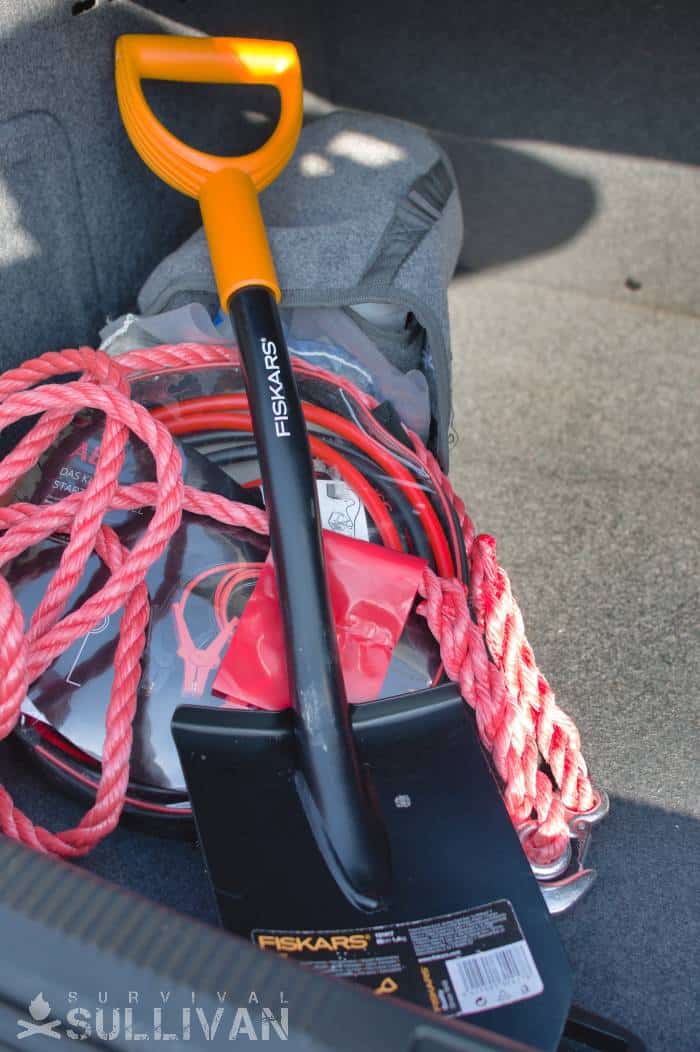
A Few More Tips
- Keep a list of edible and poisonous plants in your area and a pocket translation dictionary for the language you’ll need to communicate in, if any.
- Positive identification, such as a passport, social security card or driver’s license, is a good idea if you need to prove who you are or clear a foreign border. Keep these tightly sealed in a waterproof sleeve and make copies.
- Other useful documents for your BOB include emergency contact numbers of family members, your doctor, the police, the Embassy and non-profit organisations such as the UNHCRR.
- Take defensive driving lessons, and become good at things like driving a car in reverse, going around obstacles and so on.
- Depending on the nature of the emergency, having official documents such as firearm permits and prescriptions.
How to Conceal The Items
The best bug out bags are discreet and don’t resemble BOBs at all. While you may be tempted to opt for a heavy-duty, military-style pack, think about how conscious this would be to people accidentally looking inside your trunk.
It’s best to keep the color neutral. Don’t flash your preps no matter how awesome a job you’ve done of putting them together, because you may become an easy target for looting in times of peril.
If you have the luxury, aim to keep some space left over: your BOB needs to fit things that you scavenge along the way, once SHTF. Otherwise you’ll have to use your hands to carry these, slowing you down and making you vulnerable to outside threats.
You should review your BOB every six months and alter it in preparation for changing seasons. The bag itself should be equipped with pockets, zips and compartments for easy organization and access.
BOBs are very personal things: no two are alike, although all should contain the bare necessities for optimal survival. What are your BOB must-haves?
Be sure to get our car bug out back checklist, and don’t forget to pin this for later on your favorite Pinterest board!
updated 03/26/2021 by Dan F. Sullivan

My dad was military. My grandfather was a cop. They served their country well. But I don’t like taking orders. I’m taking matters into my own hands so I’m not just preparing, I’m going to a friggin’ war to provide you the best of the best survival and preparedness content out there.

Good list, however a couple suggestions. 1) I keep a small cooler by my front door that I take with me in the event that I travel further than a days walk home with food. Keeping your food in your bag subjects your food to 100 plus degrees. Food doesn’t like that. 2) While I explored the eating of wild edibles, there is proof that your body would rather have you fast than eat a meager 1000 calories or less in a day. Look into the actual calorie count. I’m not sure what it is. Unfortunately, carrying a gun in CA. is not to much of an option, however having a gun in your locked trunk going to the range is allowed, so in the event SHTF, you will have it with you when SHTF.